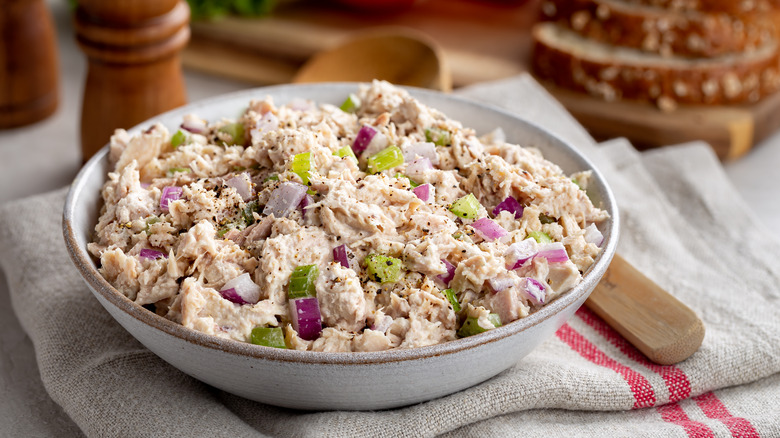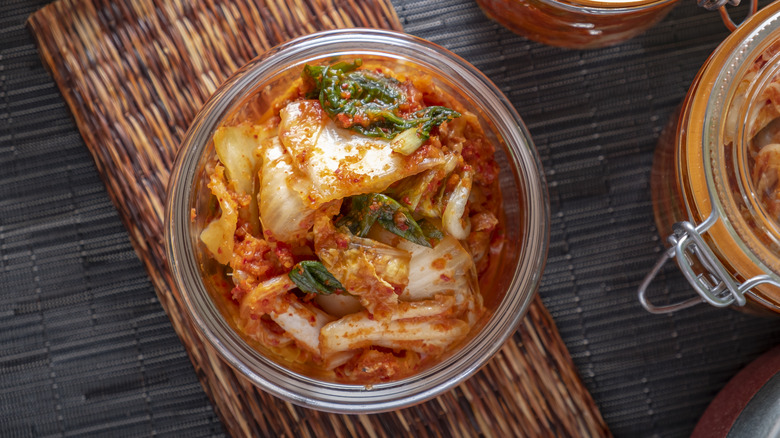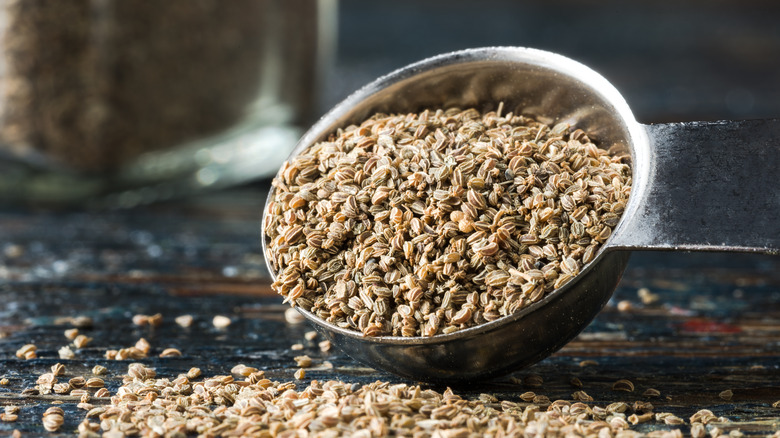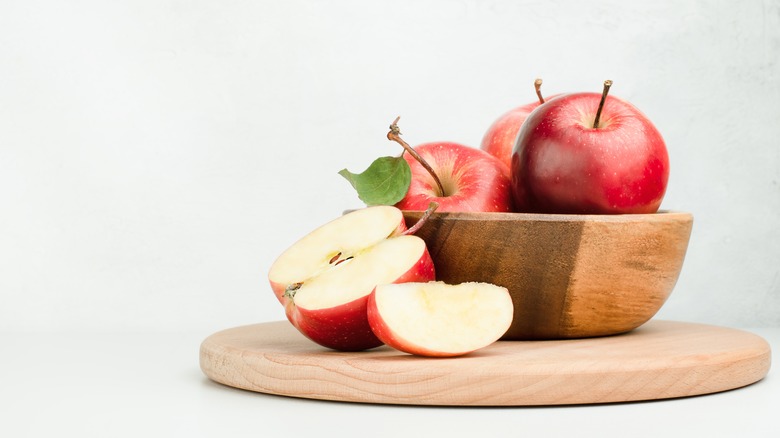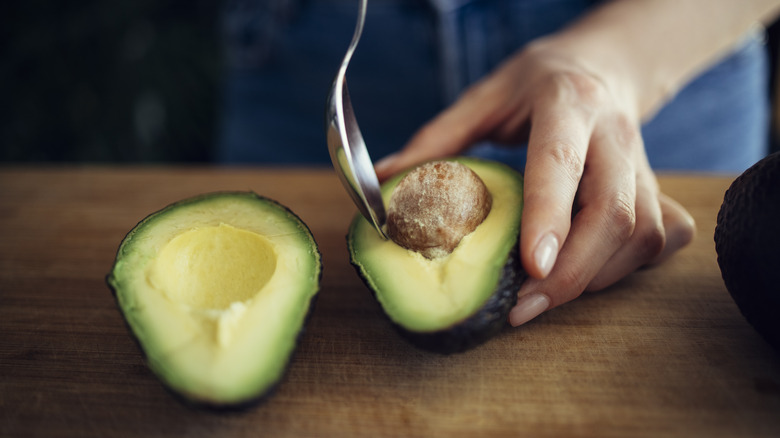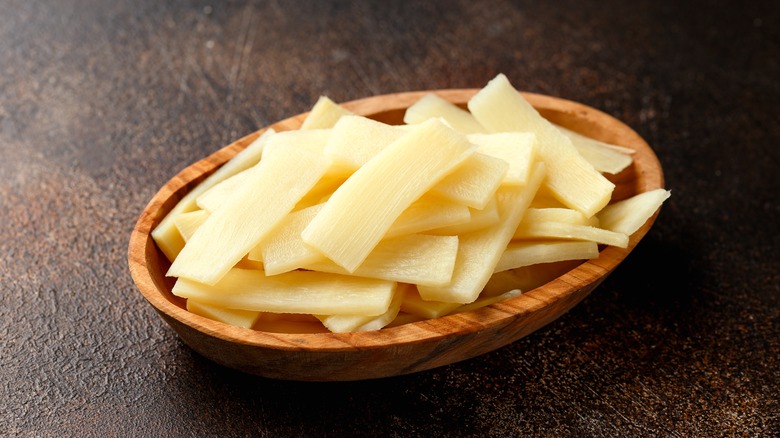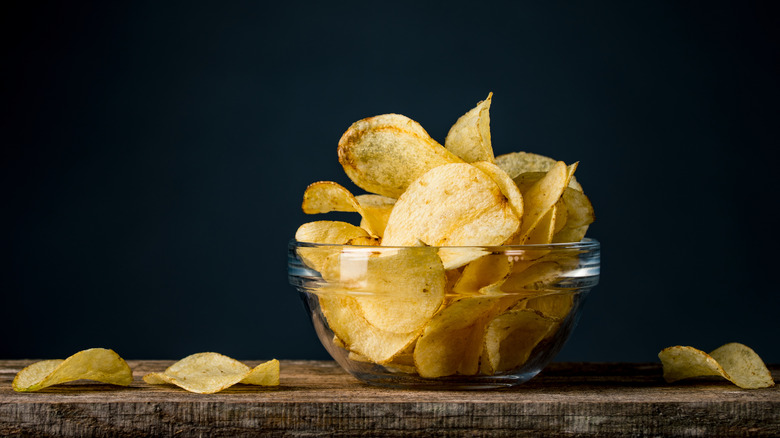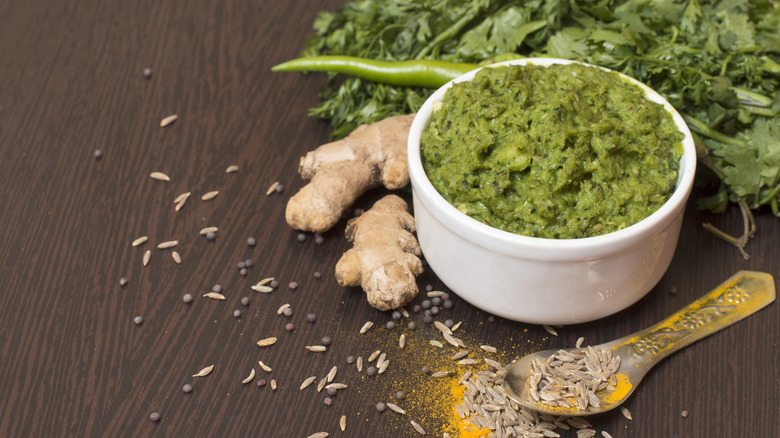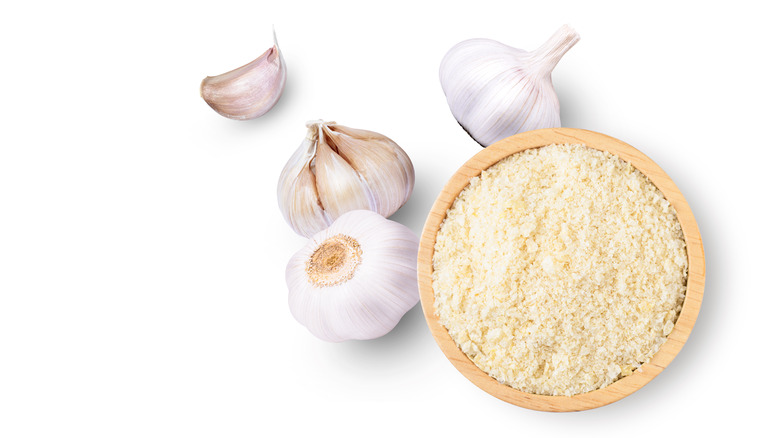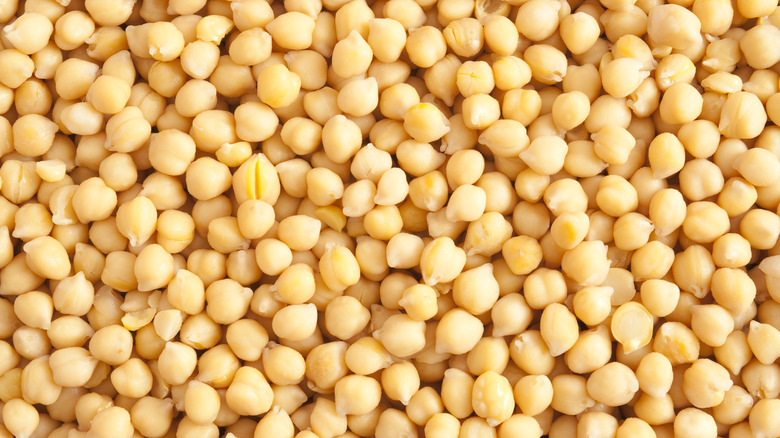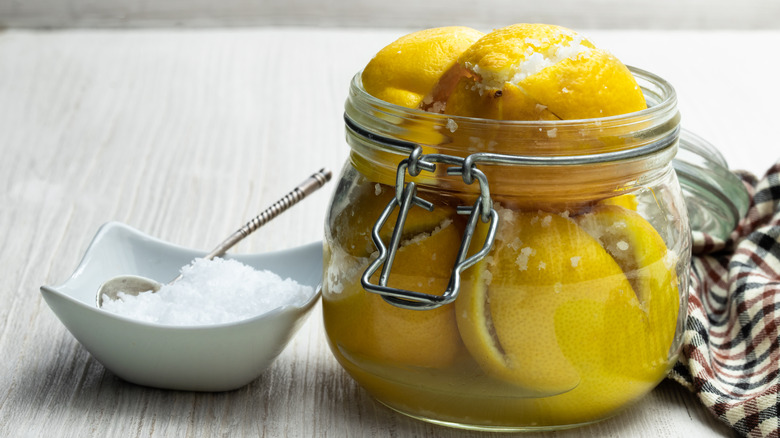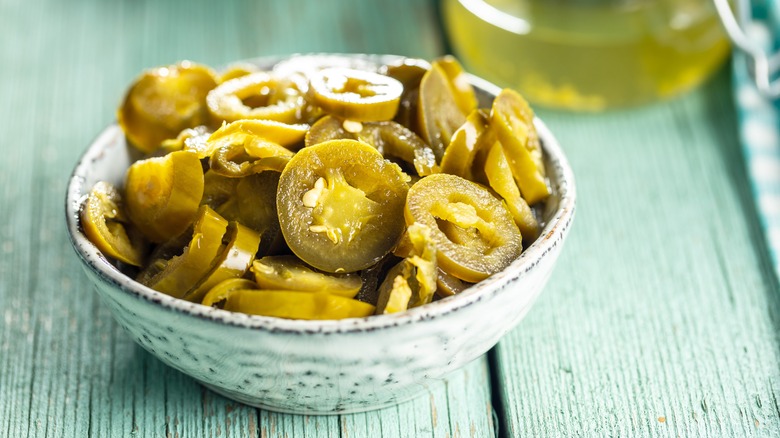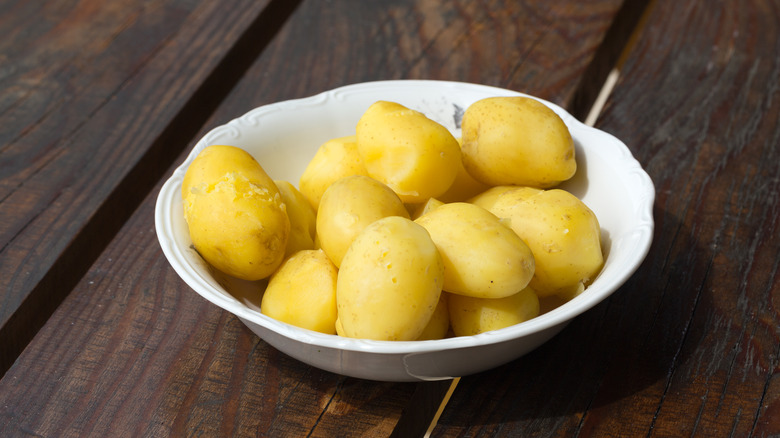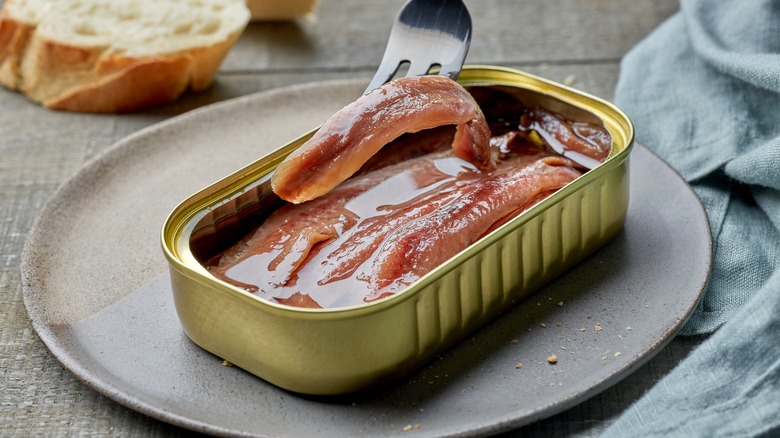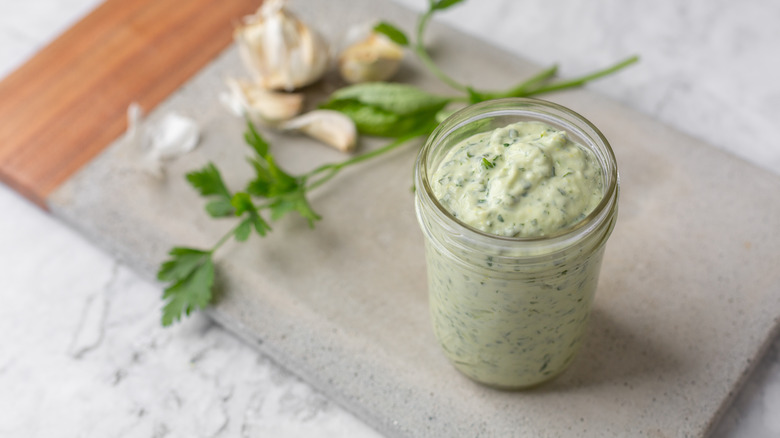14 Unexpected Ingredients You Should Put In Tuna Salad
Tuna salad is one of the easiest and most satisfying lunch recipes out there. To make a traditional tuna salad, you need little more than a can of tuna, some mayonnaise, a few crunchy elements like chopped onion and celery, and some easy-to-find flavorings like mustard, lemon juice, salt, and pepper. All of these things combine to make a food that's delicious in sandwiches, on crackers, mixed with pasta, or piled on top of some greens, and packed with protein and important nutrients like iron and vitamin B6.
However, while the flavor of tuna salad is reliable and always enjoyable, it's also easy for it to become boring. And that's why it's important to mix things up now and again. As a mixed salad, tuna salad benefits enormously from additional ingredients that can add contrasting textures or new flavor notes that lift the meal beyond its regular confines or else bulk out the dish to make it a meal in itself. And as the base flavor of tuna salad is relatively mild, it works very well with some surprisingly punchy ingredients, which can bring spice, funk, or lip-puckering sourness. And some of those ingredients may be sitting in your fridge right now.
Kimchi
If you want to make your tuna salad game way more interesting, throwing in some spicy, crunchy kimchi is the way to go. Kimchi adds an enormous amount of taste in a relatively small quantity and reinforces several of your tuna salad's inherent flavors. The dried shrimp and fish sauce, which give kimchi its brininess, pair effortlessly with the milder fishy notes of the tuna. The crunchy texture of kimchi, made from cabbage and carrot, also goes superbly with any other vegetables you're using in your salad.
Kimchi's funkiness, which comes from its fermentation process, also adds an entirely new element to the dish, and its umami notes boost the savoriness of tuna salad. As well as this, kimchi is full of spice, which makes the salad way more interesting and cuts through the density that tuna salad can sometimes develop. Just ensure you're cutting up your vegetables finely so they are evenly distributed throughout the food. If you don't want to use the vegetables in kimchi, or you're nearing the end of the jar, using some of the kimchi juice is a good way to pack concentrated flavor into the meal.
Celery seeds
Celery does more than deliver crunch in a tuna salad. It also gives the meal a lightly nutty flavor and packs it with juiciness from the water content in the vegetable. But for those times when you want to amp up the taste of celery, celery seeds are the ingredient you need. Celery seeds provide all of celery's grassy, herbal taste but in concentrated form. Using them in tuna salad creates a dish that has a concentrated, punchy flavor with a more intense taste in smaller amounts. It's also a great choice for people who like their tuna salad smooth, without crunchy bits.
Celery seeds are best pounded lightly in a pestle and mortar before being placed in tuna salad. Because you won't be cooking them, they won't soften much when mixed into the salad, so grinding them slightly will break them down. Doing so will also release their flavor more effectively. As celery seeds have such a pronounced flavor, you should avoid using too many of them, as it will introduce an aniseed taste to your tuna salad that will distract from the dish. You can also use celery salt in place of celery seeds, but bear in mind that this will increase your food's sodium content.
Apple
Tuna salad is an intensely savory dish. And while this is usually a good thing, sometimes it can mean that it ends up lacking in any complexity or balance from other flavors. But a bit of chopped apple can make all the difference. This ingredient, championed by Martha Stewart, brings a taste that's undervalued when it comes to tuna salad: sweetness. This sweetness helps to slightly diffuse the saltiness of the fish and makes everything taste way more rounded without losing any intensity.
Apple is also a better choice than adding granulated sugar or honey, and it provides further texture and crunch, as well as some valuable fiber, which you'll get even more of if you leave your apple peel on. You can mix it up with different types of apples to accentuate certain flavors. For example, going for a sour green apple will bring extra sharpness to the tuna salad. A Fuji apple, on the other hand, will deliver a large amount of sweetness. If you really want to keep things in the apple family, swap out the lemon juice you'd normally use for apple cider vinegar.
Avocado
Tuna salad is usually held together by mayonnaise, which turns the tuna from being overly dry and chalky to a rich, creamy, moreish mass. But what if you can't eat mayonnaise? While you can find vegan mayonnaise in most supermarkets these days, we recommend using a different ingredient entirely: avocado. Mashed avocado is just as creamy as mayonnaise, making it the perfect choice for a paleo tuna salad. It also gives your tuna salad a gently nutty flavor and works excellently with the other ingredients that usually go into the salad, like onion and lemon juice.
Additionally, avocados are full of healthy fats, as well as fiber, and numerous vitamins and minerals. If you prefer to keep things chunky, you can use avocado for that, too. Cube it up instead of mashing it and mixing it through your tuna salad, using an alternative fat like olive oil to bind things together or adding regular mayonnaise back in. This is a particularly good option if you've picked up avocados that aren't quite ripe enough to be mashed but still want the avocado's rich taste and nutrients.
Bamboo shoots
There are plenty of crunchy ingredients that you can throw into tuna salad, but for some reason, we always fall back on celery. One replacement for celery can also give your food an entirely new flavor: bamboo shoots. Bamboo shoots have a sweeter flavor than celery and an undertone of nuttiness that brings depth to the meal. Like artichokes, they also have a grassy edge, and their subtle complexity works well against the bolder flavors of the fish, onion, and lemon juice.
Bamboo shoots are an awesome choice because the canned version stays crunchy even when it's packed in water. This means that if you don't have any fresh celery in the fridge, you can open a can of bamboo shoots, slice them up, and throw them in. Bear in mind that bamboo shoots can often come packed in brine, and this can make your meal taste quite salty, especially if your tuna has also been canned in salt water. To avoid this, try to find bamboo shoots packed in just water. Alternatively, give them a thorough rinse before using them to make sure any excess salt drains off.
Chips
If you've ever wanted to make your tuna salad sandwich the best it's ever been, chips are the way to go. Chips give your tuna salad a super-crisp crunch that raw vegetables don't provide and a hit of salt that heightens the flavor of everything else. As they come in many different flavors, you can pair your chips to your individual tastes. Spicy chips can work well to give the tuna salad additional heat, whereas salt and vinegar chips mingle with the meal's natural fishy flavors and give it extra sourness.
Naturally, if you want the best crunch, you need to go for the most robust chip out there. Ruffles or Fritos make an excellent choice, thanks to their ability to stay crispy even when moisture from the salad is introduced. Brittle potato chips, like Kettle Chips, also hold their shape and texture well, as do regular Lay's. When adding chips to tuna salad, you'll want to ensure you do so just before eating so they don't become soggy. It's also best not to mix them directly into the tuna salad itself, but instead layer them on top of the salad in your sandwich or crumble them over it if you're eating it another way.
Chutney
Curry flavors work well with most fish, and tuna is no exception. While you can throw in a few dashes of curry powder to bring complexity to tuna salad, using chutney also brings additional elements like sweetness, freshness, and fire, depending on the type you use.
You can use pretty much any chutney you like in tuna salad, although we'd advise steering clear of particularly intense flavors like hot lime. Stronger-flavored chutneys have a tendency to become the predominant taste when put in tuna salad and will overtake anything else you add to the dish. Jarred mango chutneys are a great way to give the meal a spice-infused nuance while amping up the sweetness. Coriander chutney gives tuna salad an herbal kick and some gentle heat and imbues the whole dish with a bright green tone that makes it visually appealing.
Chutneys can be stirred through your regular tuna salad mixture or used as a spread on your sandwich, which helps to keep the flavors distinct and individually striking. Other types of relish also work well with the dish, although we'd again recommend using milder ones to avoid unbalancing your flavors.
Garlic powder
A quick and easy way to give your tuna salad instant depth is sitting right in your spice rack. A few shakes of garlic powder or a sprinkling of garlic salt can immediately add allium flavor notes to your tuna salad. While this may seem like it could be overpowering, the garlic is a natural fit with the raw onion in most tuna salad recipes. Garlic can also help take some of the edge off fishy tuna salads.
Remember, though, that adding garlic powder alone won't do much. You'll need a good amount of fat to activate the flavor properly. While mayonnaise will provide this, stirring in some additional oil is the best way to go, as the oil's slightly peppery flavors lift garlic enormously.
However, the taste of garlic powder can be a little bit basic for some people. If that's the case for you, try sautéeing some chopped garlic in a good amount of olive oil before stirring the two into the tuna mixture. Sautéeing it will take the edge off that raw garlic taste and develop sweet and caramelized flavors in the vegetable, which serve to make the tuna salad richer.
Chickpeas
Canned chickpeas are often relegated to the same old recipes, but this versatile ingredient deserves more. And that's why we love putting it in our tuna salad. Chickpeas already make an excellent tuna substitute in chickpea salad sandwiches, with the soft, slightly flaky texture of the crushed legume emulating tuna excellently. However, mixing them in with tuna helps to create a tuna chickpea salad that's bursting with additional fiber and nutrients.
Chickpeas also have the added benefit of a slightly milder flavor than the fish. As such, using them is a great choice for kids who might prefer a less briny-tasting sandwich. Chickpeas provide textural variation; you can mash them to your desired consistency or leave them whole.
Just bear in mind that while adding mashed chickpeas can give tuna salad added softness and creaminess, this will only occur if you're balancing them with the right amount of fat. If you don't, the whole thing will end up tasting chalky and way too dense. A good tip is to add a splash of milk alongside your mayonnaise. As milk has a similar flavor profile, it won't distract from the other tastes in the dish but will moisten the mixture so that it's easily spreadable.
Preserved lemons
Lemons and tuna are a match made in heaven. But just adding lemon juice can be surprisingly ineffective. While lemon juice gives tuna salad an acidity vital to the dish, brightening it up and stopping it from being relentlessly savory, it doesn't provide much lemony taste. To do that, you need some of the lemon oils, which live in the zest.
You can certainly add lemon zest into the mix, but we prefer to be a little more confident by throwing in some chopped preserved lemons. Preserved lemons are a pickled version of the fruit, and this pickling procedure gives the fruit a funky, sour, and deeply lemony flavor. Their distinctive taste makes tuna salad both lemony and even more savory.
When using preserved lemons, it's vital to proceed carefully. As they have such a strong flavor, adding just a bit too much can cause your tuna salad to become too sour. Ensure that you chop them up very finely so that none of your guests end up with a mouthful of lip-puckering lemon. Furthermore, as preserved lemons are packed in salt, it's wise to resist adding extra salt until you have done a taste test. If you find the flavor of preserved lemons too strong, remember that you can always add some lemon zest instead — but keep in mind that with that, too, a little goes a long way.
Jalapeños
Adding heat to tuna salad is one of our favorite ways of unlocking the meal's hidden potential. And while there are many ways to do so, our favorite is by adding chopped jalapeños. Jalapeños have the advantages of being not just spicy but also sour and salty, thanks to being pickled. As a result, they add a significant amount of flavor in a very small quantity.
Jalapeños are also a great option as, unlike other chilis, the heat they provide is relatively mild and fragrant. Although their mildness does, of course, depend on the type of jalapeños you find — some can be pretty hot. As the heat from jalapeños can take a little while to disperse through tuna salad properly, it's best to mix them in and allow it to sit for 5-10 minutes before doing a taste test and adding more if necessary.
For instant chili flavor without having to slice anything up, you can also pour in a bit of jalapeño brine. Doing so can be a good way to save on food waste. While you can use other types of chilis, bear in mind that using fresh ones can give tuna salad a potent, slightly harsh taste.
Potatoes
Tuna salad is one of those recipes that you can double up on easily. However, finding extra ingredients that add sufficient bulk can be tricky if you only have one can of tuna. This is where potatoes really come into their own. Potatoes are a cost-effective and easy-to-prepare ingredient for tuna salad that makes the dish altogether more filling and won't distract from the primary flavors of tuna, onion, and mayonnaise.
Using potatoes also creates newfound potential in the classic tuna salad. If you desire, you can steer it away from the traditional mayo-laden version and create a fresher salad akin to a niçoise, with an oil-vinegar dressing, using potatoes, tuna, celery, and eggs. If you like your tuna salad creamy, potatoes, with their soft and pillowy texture, will contribute to this hugely. You can even mash your potatoes fully and mix them with the mayonnaise, creating an ultra-thick dressing for your other ingredients.
Remember that different potatoes will give tuna salad different flavors. For a lighter, sweeter taste, go for new potatoes, boiled gently and sliced in half. If you want a more classic buttery flavor, Yukon Gold or Russet potatoes will hit the spot.
Anchovy paste
Tuna is an umami-packed seafood, and as such delivers a deeply savory flavor. But there are times when you really want to lean into this and create a meatier flavor for your tuna salad, without the use of meat itself. Anchovy paste is the perfect solution for this. Anchovy paste is a key ingredient in Ina Garten's tuna melts, which she uses as a way to round off the flavor of the dish and balance the sharper flavor of lemon juice — and crucially, it won't make your food taste fishy. "It just gives a little extra depth of flavor, and you don't know it's anchovies," Garten says on the Food Network YouTube channel.
Anchovy paste gets its umami flavor from its high level of glutamates, compounds that create a meaty richness and which are also found in soy sauce, fermented foods, and mushrooms. If you don't have any anchovy paste, you can also use jarred anchovies. Bear in mind that jarred or canned anchovies have a stronger taste than anchovy paste, so you should use less of them. You should also chop them up as finely as possible to avoid getting a huge chunk of anchovy flavor in one bite.
Green Goddess dressing
Although tuna salad's pale grey color is normal, the meal hardly wins any prizes for its appearance. But by using Green Goddess dressing in place of mayonnaise, you can create an attractive-looking tuna salad with loads of flavor. Green Goddess dressing starts with a base of mayonnaise and sour cream, to which lemon juice, anchovy fillets, white wine vinegar, and an abundance of fresh herbs are added. The result is a sauce that resembles the traditional tuna salad dressing of mayonnaise and lemon juice but with extra fragrance and depth.
While parsley, chives, and tarragon are traditionally used in Green Goddess dressing, you can mix yours with any desired herbs. Try blitzing in some coriander for a slightly spicier version, or mix in some basil to give it a hint of sweetness. Mixing in a few sprigs of mint can give the dressing an added brightness, whereas dill can add a citrusy edge. You can also add in additional flavor elements like capers of finely chopped black olives, which pair well with the tuna.
